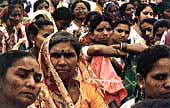Made In India examines the Self-Employed Women’s Association, an organization that acts as a union and organizing body for poor, self-employed Indian women such as embroiderers or street vendors. Directed by Patricia Plattner, the film incorporates interviews with SEWA’s founders and with self-employed SEWA members, as well as footage of the women working or organizing in the style of cinema verite.
SEWA was founded in the belief that those who worked in the “unorganized sector” – that is, without a main employer such as a factory – could benefit from the solidarity and self-empowerment of being in a union. SEWA founder Ela Bhatt notes that organizing would give women the ability to feel more confident about their work and to dispel the shame surrounding these women’s jobs.
For example, one woman named Geeta works as a rag picker, which involves sorting through city trash to find recyclable cardboard and plastic. SEWA communicated with local middle-class communities so that residents set their trash out for rag pickers to collect, thus improving the conditions in which these women work. Geeta describes how after this change, the middle-class residents will ask for her if she doesn’t come around for a while – her job now carries less social stigma.
In addition to improving working conditions, SEWA focuses on increasing the economic mobility of their members. Because many women had incurred debts since they are short on capital, SEWA started a bank that would give out small loans to self-employed women. SEWA’s bank was unusual in that it was willing to give loans to very poor and often illiterate women. Further, SEWA ensured that the bank’s tellers included rag pickers, vendors, and other self-employed women, so that the women themselves decide who gets loans.
Near the end of the film, one woman says “times have changed,” noting how husbands will now listen to what their wives have to say. The increased economic benefits from SEWA have shifted power structures at home, and the film demonstrates how SEWA’s organizing has impacted the lives of thousands of self-employed women. Made In India provides a striking portrait of an organization that is successfully transforming a economically divided country.
Women Make Movies link: http://www.wmm.com/filmcatalog/pages/c488.shtml#relatedtitles
Further Reading:
[1] Datta, R. (2003). From Development to Empowerment: The Self-Employed Women’s Association in India. International Journal of Politics, Culture, and Society, 16(3). Retrieved from http://www.jstor.org/stable/20020171
[2] Isaacs, S., Bombaywala, A., Desai, R., Parmar, R., Patni, C., Shah, M., & Shaik, K. (1994). Banking on Self-Employment. Agenda, 23. Retrieved from http://www.jstor.org/stable/4065953

